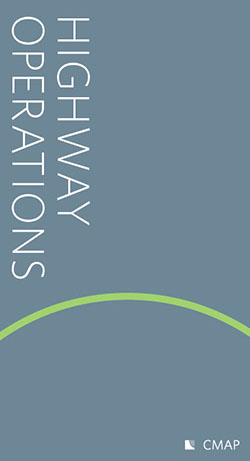HIghway operations strategy paper landing page
Update: The Highway Operations ON TO 2050 strategy paper is now available, and your feedback is welcome. Send your thoughts, ideas, or questions to ONTO2050@cmap.illinois.gov.
Improving highway management and operations is essential to reducing congestion in our region.
National research has shown that an imbalance between demand and capacity accounts for about 40 percent of congestion. We often refer to this as recurring congestion, which drivers learn to expect and plan for each day. ON TO 2050 will address this type of congestion in part through a list of major capital projects prioritized for significant impact on the capacity of the region's transportation system.
The remaining 60 percent of congestion nationwide is non-recurring and caused by incidents, poor signal timing, special events, and weather, among other factors. These sources of congestion are best addressed by operational changes rather than capacity improvements.
Travel time unreliability caused by non-recurring congestion is difficult for individuals and businesses to plan for when scheduling daily travel or deliveries. Including extra travel time to account for potential unreliability is an additional cost of travel. Modern system management, which improves incident response, traffic signal operations, work zone operations, weather operations, and traveler information helps reduce unreliability, thereby supporting our economy and improving our quality of life.
ON TO 2050 can support modern traffic management.
Modern transportation system management requires the ability to monitor system performance, communicate desired changes to field equipment from a central location, coordinate activities between multiple agencies, and provide accurate information to the traveling public, all in real time. This can only be accomplished with a reliable and robust fiber optic communication system, modern equipment, trained and equipped operations staff, and procedures in place to ensure that conditions are addressed effectively as they arise.
ON TO 2050 will build on successful approaches such as the Lake County PASSAGE system, which monitors traffic to allow fast response to changing conditions, communicates with emergency responders about incidents, and provides information to travelers. The region's system operators are planning for a future of active traffic management where lane designations can be changed in real time to keep travelers away from a stalled vehicle or speed limits modified depending on traffic conditions. Many small operational changes can make a large impact. For example, regular signal retiming or even changes in emergency traffic response practices can improve system operations.
This is your plan.
Continual input by stakeholder organizations and individuals was vital to the development and implementation of GO TO 2040. From now through the next plan's adoption in October 2018 and beyond, CMAP will be engaging a broad cross-section of partners from across the region.
Take a moment to fill out the questions below, and for more information on CMAP's public engagement efforts, please visit www.cmap.illinois.gov/get-involved.

